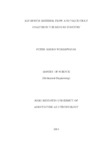| dc.description.abstract | Vision 2030 is Kenya’s development blueprint aiming at making the country a newly industrialized middle income nation, and providing high quality of life for all the cit-izens. In support of this vision, this research work aimed at investigating the supplychain systems and demand for aluminium in Kenya. This is because aluminium has practically replaced copper in high-voltage transmission lines in Kenya. The othermajor uses of aluminium in Kenya include: domestic and industrial construction,packaging (aluminium foil, cans) and kitchenware. Material categories and transfor-mation processes were identified and the material flows examined. Aluminium con-sumption, production and availability was determined by collecting secondary data from Kenya National Bureau of Statistics, Kenya Bureau of Standards, Ministry of Environment and Natural Resources, and Kenya Association of Manufacturers. Theprimary data and effects were acquired from the industry players through question-naires that were distributed and interviews carried out in specific industries. Theanalysis was carried out through Material Flow Analysis and Value Chain Analysis.Annual collective data on aluminium consumption, production, and efficiency toassist in running aluminium industry has not been available to users. Therefore there was a need to avail the data on the market in order to get a clear understanding and information on aluminium material transformation, consumption, productionand use by the government and potential investors in Kenya.The study established that from 2003 to 2007, local bauxite, imported bauxite, im-xxiii
ported billets, coils and ingots, imported semi fabrications and castings, imported scrap and local scrap consumption increased steadily by 35% , 55% , 37.1% , 35% ,197% and 241% respectively. The year 2008 recorded a slight drop due to the 2007political instability. Imported bauxite, unwrought aluminium and and wrought aluminium consumption was projected to increase by 53.1% , 54.9% and 32.8% re-spectively between the years 2009 and 2019. During the period of study, aluminium sector recorded Material Efficiency, Energy Efficiency and Capacity Utilization rate means of 80.95% , 26.68 mt/TJ and 48.84% respectively. The local industry effi-ciencies compared too low to the global Material Efficiency, Energy Efficiency andCapacity Utilization rate that varied between 92% to 98% , 80 mt/TJ to 92 mt/TJand 81% to 93% respectively. Information on use of aluminium material in itsprimary and secondary states was provided.The findings of the study will be useful to the private sector and government whenestablishing the cost of transformation, consumption and production that may leadto investing in aluminium processing plant in Kenya. Value chain analysis will pro-vide the basis of determining the material costs that are incurred at each stage of the production cycle for this material, which will consequently facilitate the formulation of a long-term duty structure. This will form the basis for informed and supportive decisions from policy makers and during trade negotiations over tariffs with other countries. Current and potential investors will be able to forecast market trend sin terms of aluminium material availability and efficiency by comparing with the
global trends | en_US |

